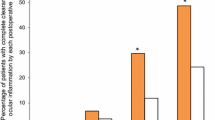Abstract
Introduction
We compared the prostaglandin E2 (PGE2) inhibition of three topical nonsteroidal antiinflammatory drugs (NSAIDs): ketorolac 0.45%, bromfenac 0.09%, and nepafenac 0.1% at peak dosing levels in patients previously scheduled to undergo phacoemulsification.
Methods
This was a single-center, double-masked observational study of 121 patients randomized to one of three NSAID treatment arms. Patients were instructed to take the NSAID per on-label dosing (twice daily [b.i.d.] for ketorolac 0.45% and bromfenac 0.09%, three times a day [t.i.d.] for nepafenac 0.1%) for 1 day before surgery, and were to instill one drop the morning of surgery. Each patient received an additional four doses 1 hour prior to undergoing phacoemulsification. After completion of the paracentesis site with a super blade, aqueous humor (0.15 mL) was collected through the peripheral clear cornea with a 30 G needle attached to a tuberculin (TB) syringe. Aqueous humor samples were stored at −40°C prior to analysis, and diluted 1:10 with diluent. Assays were conducted on multiple plates in duplicate (seven standards per plate).
Results
The mean (±SD) PGE2 concentrations were 224.8±164.87 pg/mL for ketorolac 0.45% (n=42), 288.7±226.05 pg/mL for bromfenac 0.09% (n=41), and 320.4±205.6 pg/mL for nepafenac 0.1% (n=38). The difference between ketorolac 0.45% and nepafenac 0.1% was statistically significant (P=0.025). The difference between bromfenac 0.09% and nepafenac 0.1% was not significantly different (P=0.516).
Conclusions
Ketorolac 0.45% achieved the greatest inhibition of PGE2 compared to nepafenac 0.1% and bromfenac 0.09%. Ketorolac 0.45% may be more efficacious at controlling inflammation at the time of cataract surgery versus nepafenac 0.1% and bromfenac 0.09%.
Similar content being viewed by others
References
Walters T, Raizman M, Ernest P, Gayton J, Lehmann R. In vivo pharmacokinetics and in vitro pharmacodynamics of nepafenac, amfenac, ketorolac, and bromfenac. J Cataract Refract Surg. 2007;33:1539–1545.
Koay P. The emerging roles of topical non-steroidal antiinflammatory agents in ophthalmology. Br J Ophthalmol. 1996;80:480–485.
Warner TD, Mitchell JA. Cyclooxygenases: new forms, new inhibitors, and lessons from the clinic. FASEB J. 2004;18:790–804.
Goguen ER, Roberts CW. Topical NSAIDs to control pain in clear corneal cataract extraction. Insight. 2004;29:10–11.
Donnenfeld ED, Holland EJ, Stewart RH, Gow JA, Grillone LR. Bromfenac ophthalmic solution 0.09% (Xibrom) for postoperative ocular pain and inflammation. Ophthalmology. 2007;114:1653–1662.
Arshinoff SA, Opalinski YAV. The pharmacotherapy of cataract surgery. In: Yahoff M DJ, ed. Ophthalmology. 2nd edition. Philadelphia: Mosby Elsevier. 2008:434–440.
Donnenfeld ED, Perry HD, Wittpenn JR, Solomon R, Nattis A, Chou T. Preoperative ketorolac tromethamine 0.4% in phacoemulsification outcomes: pharmacokinetic-response curve. J Cataract Refract Surg. 2006;32:1474–1482.
Perry HD, Donnenfeld ED. An update on the use of ophthalmic ketorolac tromethamine 0.4%. Expert Opin Pharmacother. 2006;7:99–107.
Price MO, Price FW. Efficacy of topical ketorolac tromethamine 0.4% for control of pain or discomfort associated with cataract surgery. Curr Med Res Opin. 2004;20:2015–2019.
Sandoval HP, De Castro LE, Vroman DT, Solomon KD. Evaluation of 0.4% ketorolac tromethamine ophthalmic solution versus 0.5% ketorolac tromethamine ophthalmic solution after phacoemulsification and intraocular lens implantation. J Ocul Pharmacol Ther. 2006;22:251–257.
Solomon KD, Donnenfeld ED, Raizman M, et al. Safety and efficacy of ketorolac tromethamine 0.4% ophthalmic solution in post-photorefractive keratectomy patients. J Cataract Refract Surg. 2004;30:1653–1660.
Huang LC, Jean D, McDermott AM. Effect of preservative-free artificial tears on the antimicrobial activity of human beta-defensin-2 and cathelicidin LL-37 in vitro. Eye Contact Lens 2005;31:34–38.
Paliwal SK, Chauhan R, Sharma V, Majumdar DK, Paliwal S. Entrapment of ketorolac tromethamine in polymeric vehicle for controlled drug delivery. Indian J Pharm Sci. 2009;71:687–691.
Torkildsen G. The effects of lubricant eye drops on visual function as measured by the Inter-blink interval visual acuity decay test. Clin Ophthalmol. 2009;3:501–506.
Xibrom. Package insert. Irvine, CA: ISTA Pharmaceuticals; 2010.
Bucci FA, Jr., Waterbury LD. Comparison of ketorolac 0.4% and bromfenac 0.09% at trough dosing: aqueous drug absorption and prostaglandin E2 levels. J Cataract Refract Surg. 2008;34:1509–1512.
Nevanac. Package insert. Fort Worth, Texas: Alcon Laboratories; 2008.
Bucci FA, Jr., Waterbury LD, Amico LM. Prostaglandin E2 inhibition and aqueous concentration of ketorolac 0.4% (acular LS) and nepafenac 0.1% (nevanac) in patients undergoing phacoemulsification. Am J Ophthalmol. 2007;144:146–147.
Bucci FA, Jr., Waterbury LD. Aqueous prostaglandin E(2) of cataract patients at trough ketorolac and bromfenac levels after 2 days dosing. Adv Ther. 2009;26:645–650.
Amico LM, Bucci FA, Jr., Waterbury LD. Aqueous penetration of ketorolac 0.4% compared with bromfenac 0.09% in cataract patients: peak and trough drug concentations. Meeting of the Association for Research in Vision and Ophthalmology (ARVO). Fort Lauderdale, FL, 2007.
Acuvail. Package insert. Irvine, CA: Allergan, Inc.; 2009.
Colin J. The role of NSAIDs in the management of postoperative ophthalmic inflammation. Drugs. 2007;67:1291–1308.
Gayton J. Concentration and dosing of ketorolac versus bromfenac. J Cataract Refract Surg. 2009;35:1319; author reply 1320.
Sher NA, Golben MR, Bond W, Trattler WB, Tauber S, Voirin TG. Topical bromfenac 0.09% vs. ketorolac 0.4% for the control of pain, photophobia, and discomfort following PRK. J Refract Surg. 2009;25:214–220.
Heier JS, Awh CC, Busbee BG, et al. Vitreous nonsteroidal antiinflammatory drug concentrations and prostaglandin E2 levels in vitrectomy patients treated with ketorolac 0.4%, bromfenac 0.09%, and nepafenac 0.1%. Retina. 2009;29:1310–1313.
Forrester JV. General and ocular pharmacology. In: Forrester JV, Dick AD, McMenamin PG, Lee WR, eds. The Eye: Basic Sciences in Practice. Philadelphia: Saunders, 2002:265–295.
Gaynes B, Onyekwuluje A. Topical ophthalmic NSAIDs: a discussion with focus on nepafenac ophthalmic suspension. Clin Ophthalmol. 2008;2:355–368.
Bucci FA, Jr., Waterbury LD, Amico LM. Aqueous penetration of ketorolac tromethamine 0.45%, bromfenac 0.09%, and nepafenac 0.1% in patients undergoing phacoemulsification. Curr Med Res Opin. 2011. In press.
McColgin AZ, Heier JS. Control of intraocular inflammation associated with cataract surgery. Curr Opin Ophthalmol. 2000;11:3–6.
Author information
Authors and Affiliations
Corresponding author
Rights and permissions
About this article
Cite this article
Bucci, F.A., Waterbury, L.D. Prostaglandin E2 Inhibition of Ketorolac 0.45%, Bromfenac 0.09%, and Nepafenac 0.1% in Patients Undergoing Phacoemulsification. Adv Therapy 28, 1089–1095 (2011). https://doi.org/10.1007/s12325-011-0080-7
Received:
Published:
Issue Date:
DOI: https://doi.org/10.1007/s12325-011-0080-7




